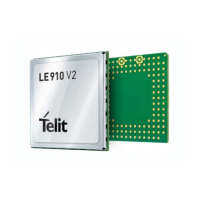Telit LE910 V2 Series AT Commands
80446ST10707A Rev. 0– 2015-11-03
Reproduction forbidden without Telit Communications S.p.A. written authorization - All Rights Reserved page 357 of 509
Mod. 0808 2011-07 Rev.2
These parts have to be a multiple of 57 bytes, except for the last
one, to distinguish EOF condition.
(Base64 encoding rules)
For the same reason if #SRECV command is used by the
application to receive data, a multiple of 78 bytes has to be
considered.
Note: to use #SRECV to receive data with <dec> enabled, it is
necessary to consider that:
reading <maxByte> bytes from socket, user will get less due
to decoding that is performed.
Note: values are automatically saved in NVM.
Read command returns the current <enc>/<dec> settings for all
the six sockets, in the format:
#BASE64:<connId1><enc1>,<dec1>,0,0<CR><LF>
. . .
#BASE64:<connId6>,<enc6>,<dec6>,0,0<CR><LF>
Test command returns the range of supported values for all the
subparameters.
Example
AT#SKIPESC=1
OK
AT#SD=<connId>,<txProt>,<rPort>,<IPaddr>
CONNECT
//Data sent without modifications(default)
………
+++ (suspension)
OK
at#base64=<connId>,1,0
OK
AT#SO=<connId>
CONNECT
// Data received from serial port are encoded
// base64 before to be sent on the socket
………………
+++ (suspension)
OK
at#base64=<connId>,0,1

